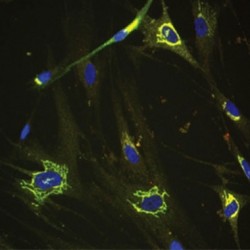By Helen Figueira
March 13, 2013
Time to read: 3 minutes
 Regulating senescence and its role in cancer
Regulating senescence and its role in cancer
Sometimes when things go wrong, it’s best to cut your losses, abandon the project in hand, and start again. This approach is more than simple common sense, it’s a biological property of our body cells when things take a turn for the worse. When a cell is misbehaving to the point of endangering its neighbours, mechanisms exist to send it into a cellular slumber, devoid of further growth or division. This state, known as senescence, can play an important role in cancer prevention. A cell on the verge of exploding in a fit of uncontrolled division can be ushered into senescence, suppressing developing tumours.
The INK4/ARF locus is the most commonly mutated DNA sequence in cancerous cells. New research published in The EMBO Journal has revealed the role this plays in tumour development. Jesus Gil (Cell Proliferation), who led the study, explains: “The locus regulates two important pathways that control the cell cycle. Usually, it triggers senescence to ‘turn the cell off’ when something is wrong, but in cancer it is deregulated, the usual checkpoints are not operational, and the cell’s proliferation spins out of control.”
“We wanted to understand the regulation of this locus,” says Gil. “By screening for transcription factors that regulate senescence, we identified HLX – a homeobox protein. Investigating further, we discovered that when you ‘knock down’ HLX, the protein p16 becomes highly upregulated.” p16 is encoded for by the INK4/ARF locus, and is crucial to senescence. Typically, it is repressed by Polycomb proteins – proteins that remodel chromatin structure to control gene expression.
Exactly how Polycomb proteins identify their targets is yet to be fully explained. The researchers started to look into the link between HLX and these repressor proteins. “We found that HLX is acting to recruit Polycombs,” reveals Gil. “It acts in the middle, between the locus and the Polycomb. This explains at least one mechanism by which these proteins are targeted.”
The next question was whether this interaction between homeobox and Polycomb proteins extended beyond this specific relationship. Homeobox proteins form a family of more than 200 transcription factors. The team screened a small sample of these to determine if other proteins from the family might behave in the same way. The result? Several other homeobox proteins were able to repress p16 in the same way. Among these was HOXA9 – an oncogene prevalent in leukaemia. “This means that the oncogenic properties of HOXA9 and HLX can be explained in part by their ability to control p16 and senescence,” says Gil.
Teasing out the details of this mechanism could mean improved treatments for a wide range of cancers. “Therapies are starting to appear that synergise with senescence,” says Gil. “Knowing that these oncogenes impair senescence to some extent means gives us a starting point to develop therapies for these particular types of leukaemia. The best way of doing that is yet to be determined, but knowing their role is an important piece of information.”
AL
Reference: Martin, N., Popov, N., Aguilo, F., O’Loghlen, A., Raguz, S., Snijders, A. P., Dharmalingam, G., Li, S., Thymiakou, E., Carroll, T., Zeisig, B. B., So, C. W. E. W., Peters, G., Episkopou, V., Walsh, M. J., Gil, J., (2013). Interplay between homeobox proteins and polycomb repressive complexes in p16INK4a regulation. The EMBO journal.
Image: Senescent cells, courtesy Jesus Gil